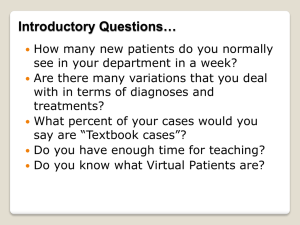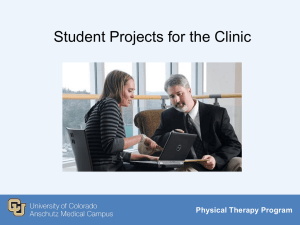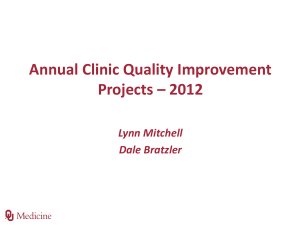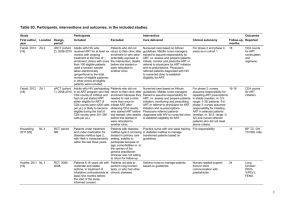Nurse Led Clinic Audit
advertisement
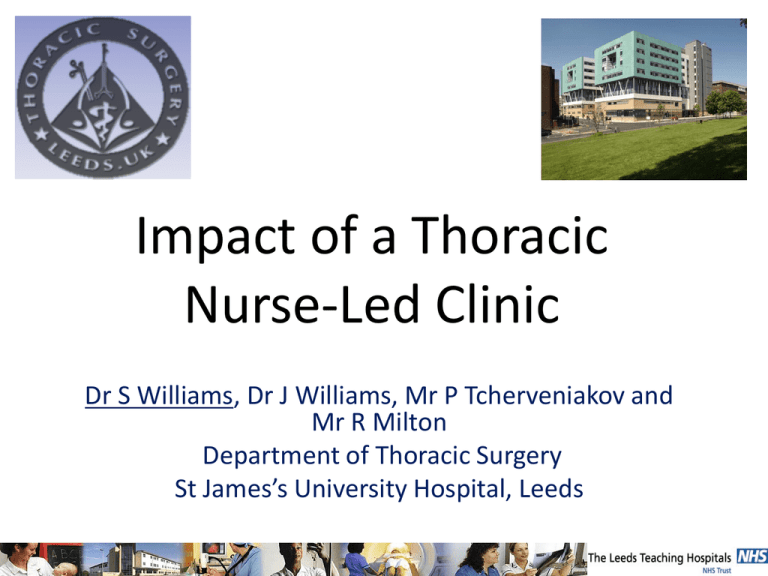
Impact of a Thoracic Nurse-Led Clinic Dr S Williams, Dr J Williams, Mr P Tcherveniakov and Mr R Milton Department of Thoracic Surgery St James’s University Hospital, Leeds Impact Of A Thoracic Nurse-Led Clinic • • • • • • • Background St James’s University Hospital Nurse-Led Clinic Method Results Limitations Conclusions Questions Background • Government endorsed since the 1990s. • Recent growth in number nurse led clinics to meet the variety in health care. • Nurses reviewing and monitoring patients’ conditions. • Aim is to reduce costs and free outpatient clinic spaces whilst maintaining a high standard of care. St James’s University Hospital Nurse-Led Clinic • Established in 2007 • Weekly clinic – treatment room on the ward. • 30 minute appointments. • Led by an experienced staff nurse • No previous assessment or audit. Method • Prospective Cross-sectional patient survey over July and August 2010. • Anonymous. • Patient demographics. • Assessing punctuality of appointment, reason for clinic visit, if doctor review was required and patient expectations and satisfaction with the experience. • Results analysed using spreadsheet software. Results • 8 Clinics • 85 patients (average 10 patients/clinic) • 83 adequately filled in questionnaires returned • Patients underwent a variety of initial procedures • The most frequent follow-up reasons were – wound management (43 patients, 52%). – Chest drain management (26 patients, 31%). Reason for initial admission Pleural procedures Parenchymal procedures Others Empyema 15 Pleurx Drain Insertion 9 Thoracic Fenestration 7 Talc Pleurodesis 6 Decortication of Pleura 2 CT guided drainage of pleural space 1 Evacuation Haemothorax 1 Lobectomy 13 VAT’s Lung Biopsy 5 Pulmonary Wedge Resection 2 Bullectomy 2 Metastatectomy 1 Pectus Repair 7 Chest wall hernia repair 2 Radio-frequency Ablation 1 Stab wound to thorax 1 Unknown 2 Total 83 Management 38 21 14 9 9 8 6 6 6 1 1 1 1 Patient Demographics 8% (7) 17% (14) 19% (16) 10% (8) 81% (67) Male Female 65% (54) 19-34 35-54 55-74 75+ Arranging appointments and Punctuality Appointment on time Length of time to wait 30mins + No 35% (29) Yes 65% (54) 15-30mins 0-15mins 0 2 4 6 8 10 12 14 Did you expect to see a Dr today? Yes 36% (29) No 64% (53) Reviewed by doctor? If yes, did you see more than one doctor? yes 38% (11) no 65% (54) Yes 35% (29) no 62% (18) Reviewed by doctor? yes 35% (29) No 65% (54) If no, do you think you would’ve benefitted from seeing a doctor? yes 7% (4) no 93% (50) Needs met at clinic? No 12% (10) Yes 88% (73) Overall Patient Satisfaction Excellent 26 (31.3%) Very Good 47 (56.6%) Good 9 (10.8%) Fair 1 (1.2%) Poor 0 (0%) Limitations • Patients filled out questionnaires and gave back to clinic nurse before leaving – bias results? • Short time period for data collection. • Need to re-audit - currently collecting more data. Conclusions • Patients find the service convenient and easy to use. • High patient satisfaction. • The clinic provides an important continuation of care. • Some aspects of care cannot be managed solely by the ‘nurse led’ clinic and require doctor input. • Obvious advantage of clinic on ward. Nurse Led Clinic in action. Questions? References 1 2 Hatchett, R. (2008) Nurse-led clinics: 10 essential steps to setting up a service. Nursing Times; 104: 4, 62-64. Annandale, J. (2008) How a nurse-led clinic cut outpatient waiting times. Nursing Times; 104: 9, 45.

